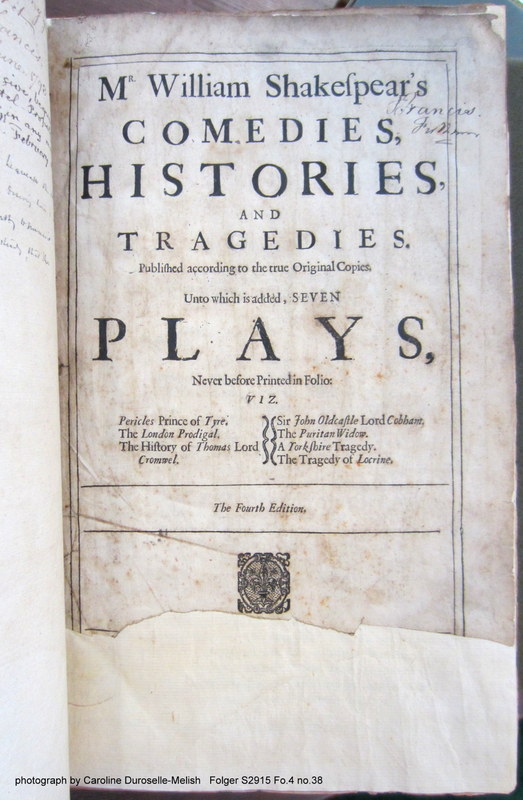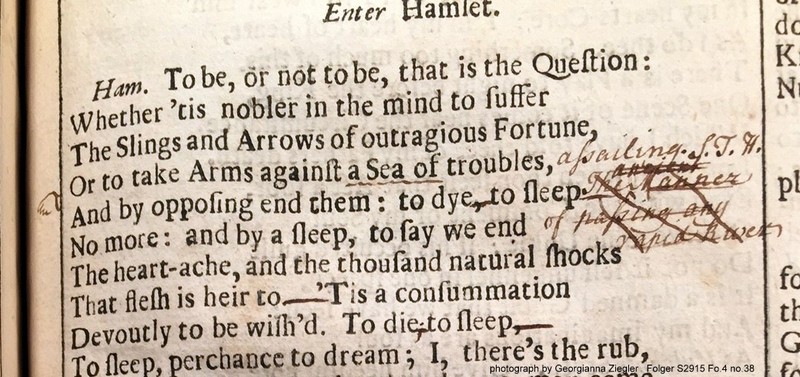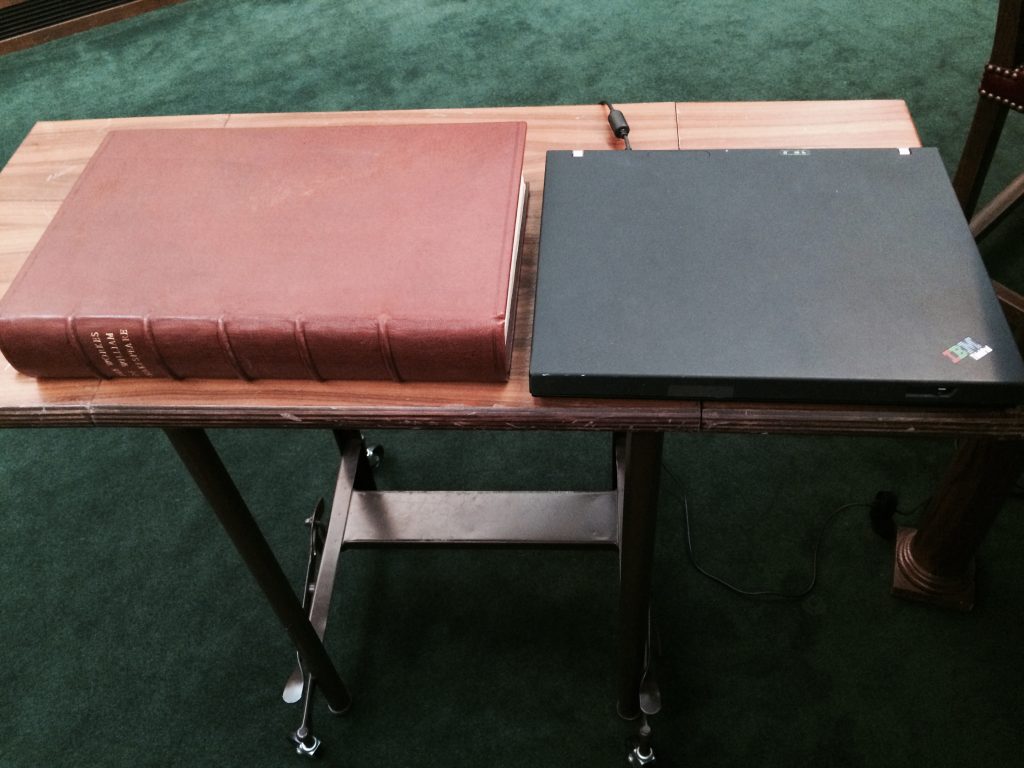
Imperfect title-page of Shakespeare Fourth Folio (1685) acquired by Folger Library in 2014
In 1889, 10 years after he graduated from Amherst College and 84 years before I did, Henry Folger walked “with fear and trepidation” into the foremost book auction house in America, Bangs and Co. on 91 Fifth Avenue. A large, thick volume caught his eye and changed his life forever. For the first time, he picked up, and fondled, a genuine Shakespeare Folio containing the Bard’s Comedies, Tragedies, and Histories. It was not the most well known First Folio (1623) respected for its authenticity and of which he had acquired a facsimile copy to present to his wife Emily Jordan Folger a few years before, but the amplified Fourth Folio (1685). He pondered how much he should bid on the volume which he decided––on the spot––he must possess. Henry bid $107.50. The Folio––printed in London two centuries earlier––was knocked down to the nervous 32-year-old. Strapped for cash, he was relieved to hear that he could pay in four installments over a 30-day period. Folger had bought his first rare book; he was hooked.
For the next forty years, Brooklyn resident Henry Folger plowed all his Standard Oil Co. investment returns into assembling the largest Shakespeare repository on the planet, including 200 Folios: 82 First Folios (1623), 58 Second Folios (1632), 24 Third Folios (1663–64), and 37 Fourth Folios (1685). Why did he collect SO MANY copies? They were ALL different in some respect: size, condition, binding, provenance, typesetting variations by several compositors, spelling variants, faulty pagination, number of genuine leaves, missing pages, marginalia. Folger’s aim was not only to collect, but to build a research library where scholars could study and analyze the fruits of his collecting mania.
Realizing he could not afford the time to attend auctions himself, Folger developed close alliances with booksellers who represented him as his commission agents. He corresponded with 600 book dealers, of whom Maggs Bros. Ltd. in London received more Folger mail than any other, over 150 letters. He wrote a (handwritten) letter to founder Uriah Maggs as early as Sept. 25, 1893. Maggs sold Folger four Fourth Folios in 1920 and 1923 that he numbered nos. 3, 5, 12, and 24 of his collection. Records show that nos. 5 and 24 cost Folger £31 10s each, minus Folger’s 10% discount for paying with ready cash. Folger sent his last (typed) letter to the firm on Shakespeare’s birthday, 1930.
April 23, 1930 turned out to be the last Shakespeare’s birthday that Henry Folger lived. He had obtained 37 copies of the Fourth Folio. Besides Emily, nobody knew he had so many. He almost bought no. 38. Maggs sent Folger a detailed typed report on March 4, 1930, tempting the collector by something he loved: an old Shakespeare item with lots of annotations in the margins. Folger was way ahead of his time in his scholarly appreciation of marginalia.

1685 volume opened to “To Be” speech in Hamlet, showing a reader’s changes/corrections to the text
Below are some marginalia from Hamlet that Folger excitedly read about in the Maggs report. On the left, I’ve indicated the page and column numbers in a Fourth Folio from which the quote is drawn. At the appropriate place in the original phrase I have put in parentheses the word a reader wrote in the margin as being better or “correct.” In this copy Folger declined in 1930, many other plays also included marginalia. These examples all come from the play most commented upon, Hamlet.
P 61 col 2. Let not thy Brother (Mother)
P 64 col 1. Or to the dreadful Sonnet (Summit) of the Cliff
P 64 col 1. And makes each Petty attire (artery) in his body
P 75 col 2. Forgive me my foul Mother (Murther)
P 75 col 2. I his foul (sole) Son
P 76 col 1. Here is your Husband like a Mildew’d Deer (Ear)
P 76 col 1. Blasting his wholesome breath (brother)
P 84 col 1. They are not near my conscience; their debate (defeat).
While the content of the potential copy no. 38 must have whetted Folger’s appetite, the price did not: £475. Maggs asked, “would you like us to send it over for your examination?” Folger responded curtly on March 17, “I will not wish this copy at the price asked for it.” Was he tired of haggling? Did he sense he had enough copies? Three months later he was dead.
To everyone’s surprise, in 2014, the Folger Library purchased––from Maggs––a Fourth Folio. Becoming the Library’s Fo. 4, no. 38, it was the FIRST Shakespeare Folio the Library had ever purchased. This 2015 blog post by Caroline Duroselle-Melish of the Folger Shakespeare Library shares the particulars of the copy: How an 18th-century clergyman read his Folio.
Recently I entered the Folger reading room and filled out a call slip for the new Fourth Folio. I awaited the special curatorial permission to view the significant acquisition. My purpose was to compare the “corrections” in the 2014 Folger Library purchase with the “corrections” in the 1930 Maggs sale. Although slim chance, I had to satisfy myself that they were not one and the same volume. I could not physically compare the 2014 purchase with the 1930 offer because Folger did not acquire the latter and I did not know who did (Maggs would know). Although I could not compare handwriting in the two copies, I could detect whether corrections were the same or different.
All eight above-listed corrections were the same in the two volumes. My face flushed with excitement! Then, spoiling my fun, they began to differ. In other plays than Hamlet they mainly differed. No dice, it was not the same copy. But how interesting, the many identical entries.

Folger Library’s recently acquired Fourth Folio slightly bigger than the laptop I keep at the Folger
(This post originally appeared on Blogging Shakespeare by Shakespeare Birthplace Trust on October 7, 2015.)
COMMENTS:
CONNECT

0 Comments